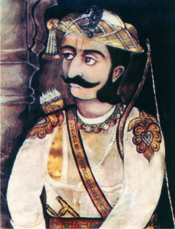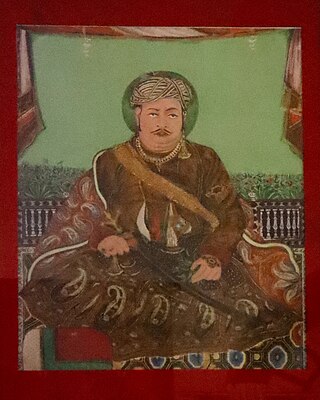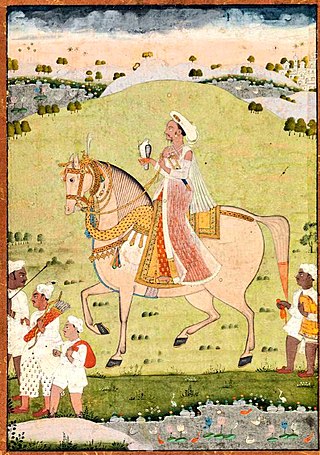
Balaji Baji Rao, often referred to as Nana Saheb I, was the 8th Peshwa of the Maratha Empire. He was appointed as Peshwa in 1740 upon the death of his father, the Peshwa Bajirao I.

Narayanrao was the 10th Peshwa of the Maratha Confederacy from November 1772 until his assassination in August 1773. He married Gangabai Sathe who later gave birth to Sawai Madhavrao.

Nagpur Province was a province of British India that covered parts of the present-day states of Madhya Pradesh, Maharashtra, and Chhattisgarh. The city of Nagpur was the capital of the province.

The Kingdom of Nagpur was an Indian kingdom within the Maratha Confederacy in the 18th and 19th centuries. It came under the rule of the Marathas of the Bhonsle dynasty in the mid-18th century. The city of Nagpur was the capital of the state.

Mudhoji II, also known as Appa Sahib, of the Bhonsale dynasty, ruled the Kingdom of Nagpur in central India from 1816 to 1818. His reign coincided with the Third Anglo-Maratha War between the Maratha Empire and the British East India Company, which ended with the defeat of the Marathas.

Raghoji I Also known as RaghojitheGreat was a Maratha general of the Bhonsle dynasty who established the Nagpur Kingdom in much of east-central India during the reign of Chhatrapati Shahu I. His successors ruled the kingdom until 1853.

Raghuji II or Raghuji was the Maratha ruler of the Kingdom of Nagpur in Central India from 1788 to 1816.

The history of Nagpur, in central India, spans over 5,000 years, including the Kingdom of Nagpur in the 18th and 19th century. Human existence around present-day Nagpur city can be traced back 3,000 years to the 8th century BC. Menhir burial sites at Drugdhamna indicate megalithic culture existed around Nagpur and is still followed in present times.

Sitabuldi Fort, site of the Battle of Sitabuldi in 1817, is located atop a hillock in central Nagpur, in the Indian state of Maharashtra. The fort was built by the British after they won this area. Mudhoji II Senasaheb Subha was allowed to continue ruling Nagpur after the British had won the battles of Sitaburdi, Sakkardara, and Nagpur. Richard Jenkins entered into a treaty with Mudhoji on 6 January 1818, which was later ratified by the Governor General. Article 7 of the treaty stated: "The two hills of Seetabuldee with the bazaars and land adjoining, to a distance to be hereafter specified, shall be henceforth included in the British boundary, and such Military works erected as may be deemed necessary." By this treaty, the British occupied the Sitaburdi hills and large areas on all four sides. However no major construction work was erected on it for next two years. The area surrounding the hillock, now known as Sitabuldi, is an important commercial hub for Nagpur. To the south is Nagpur Railway Station and behind it is Tekdi Ganapati, a temple of Ganesha. The fort was a home to the Indian Army's 118th infantry battalion Grenadiers till 2019.
Khan Bahadur Bakshi Ghulam Haider Khan was Faujdar of a unit at the time of Battle of Assaye, which was a major battle of the Second Anglo-Maratha War under the command of Major General Arthur Wellesley. Latterly, he became the royal chief head of the military services hence called the Mir Bakshi. He was in charge of intelligence gathering, and also made recommendations to the royal court for military appointments and promotions.

Raghuji III or Raghuji, was the Maratha ruler of the Principal States of Nagpur in Central India from 1818 to 1853.

Mudhoji I was the ruler of the Nagpur kingdom from 1772 to 1788. During his regency the Maratha kingdom remained peaceful and prospered.

Chand Sultan (1706-1739) was a Gond king of Nagpur. He was the eldest son and successor of Bakht Buland Shah of Deogarh. He ascended the throne of Deogarh in 1706 and shifted his capital from Deogarh to Nagpur. He carried out further reforms in his kingdom and planned layout of the new city of Nagpur and under him, the kingdom prospered. He was a kind ruler who loved his people and extended his territory considerably to the east of the river Wainganga.

The Bhonsles of Nagpur were a Maratha royal house that ruled the Kingdom of Nagpur from 1739-1853. They hailed from the Bhonsle clan of Marathas and were one of the most important and powerful Maratha chiefs in the Maratha Empire.

The Gonds of Deogarh were a Gond royal house that ruled large parts of the Vidarbha region and parts of present-day southern Madhya Pradesh. Their Kingdom consisted of the area which later became the Nagpur Kingdom. They made Nagpur region a prosperous and plentiful kingdom, founding the city of Nagpur and building further infrastructure. However, internal bickering led to their decline and they were practically made state pensioneries by the Maratha general Raghoji I Bhonsle in the 1743.

Bimbaji Bhonsle was the youngest son of Raghoji I Bhonsle, the Maratha ruler of Nagpur. Bimbaji was the ruler of Chhattisgarh on behalf of the Raja of Nagpur. However, he was only nominally subordinate to the Raja of Nagpur, as he had a separate army and court with ministers at his capital of Ratanpur.
Mohan Singh was the last ruler of the Haihaiyavanshi Kingdom, the dynasty which ruled Chhattisgarh for over 700 years. He ruled Chhattisgarh under the suzerainty of the Bhonsles of Nagpur Kingdom.
Baka Bai (1774-1858) was a Maratha stateswoman and favourite wife of Raghoji II Bhonsle, the king of Nagpur. After her husband's death, she played a key role in the intrigues at the royal court of Nagpur.

The Bhonsle dynasty is a Hindu Indian Marathi royal house. The Bhonsles claimed descent from the Rajput Sisodia dynasty, but were likely Kunbi Marathas.

Janoji I was the 2nd Maharaja of Nagpur from the Senasahibsubha Bhonsle Dynasty. He was one of four legitimate sons of Raghoji I. He succeeded his father in 1755 as Raja after succession conflicts with his other brothers. He also took part in the wars between the Peshwa Madhavrao and the Nizam of Hyderabad on behalf of Raghunathrao, both of whom later jointly sacked and burnt Nagpur in 1765. Janoji eventually conceded to pay tribute to Madhavrao I. He later died in 1772 without an heir and was succeeded by his brother Mudhoji I.
















